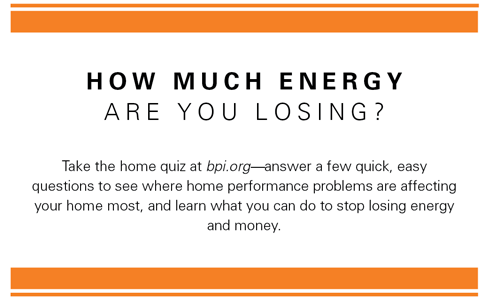
Use building science to provide solutions to comfort, efficiency, health and safety.
Imagine this scenario: Each year, your energy bills for gas and electricity keep going up, and it doesn’t seem like it is going to stop. In the middle of the summer, no one in the family wants to sleep upstairs because the air conditioning cannot keep the bedrooms cool. In the winter, there are often cold floors and condensation on the windows. Do any of these complaints sound familiar?
They are common complaints from homeowners today, in homes both old and new. Many of them realize the answer lies in making their home energy-efficient. However, they do not always know where to start. They may decide to begin with a window replacement after seeing an advertisement for a discount on the installation. Or the latest Energy Star refrigerator may be on sale at the hardware store—ready to replace the energy hog at home. The neighbors across the street just saved a lot of money on an insulation upgrade through their utility's energy efficiency program, but when getting quotes, the insulation contractors propose conflicting solutions.
With all of the marketing claims and latest scientific discoveries touting the next advance in saving energy, it can be overwhelming and confusing. Each home is unique in how it is designed and used, and there is rarely a single solution that will fit every home—what makes sense for one home may not work for another. Fortunately, there is one solution designed to cut through the noise and provide guidance based on scientific principles and backed up by diagnostic tests performed on the home. The answer is a home energy audit.
Getting Started
For the homeowner, having a professional perform a comprehensive energy audit on the home has many benefits. It is an investigation focused on improving efficiency, lowering utility bills and solving nagging comfort problems. The trained auditor will use their knowledge and equipment to determine what is wrong, how it can be fixed and options for the most cost-effective solution.
An energy audit tests and evaluates all of the systems that impact the use of energy in the home, including insulation, heating and cooling systems, lighting, appliances and electronics. For a flat fee that is generally based on the size of the home, a professional energy auditor will spend several hours using diagnostic equipment to measure and evaluate the home.
The results of the audit will be prioritized to provide a road map for an energy upgrade. Some homeowners will decide to hire a contractor right away to tackle the recommendations, while others will decide to phase in the recommendations into their already-existing remodeling plan.
Some homeowners call for an audit to solve the problem of high energy bills. What is considered a “high” utility bill will vary from home to home depending on its size, how many live in the home, what type of fuel is available and how the home is used. While a rise in the price of energy can be a factor, the cause is often rooted in one of the energy systems in the home, such as inadequate insulation, equipment failure or even changes in occupant behavior patterns. Generally speaking, $200 to $400 a month in utilities will have some opportunity for improvement, and anything from $400 to $1,000 a month will have a large opportunity for a quick payback from an energy upgrade investment.
More often than not, homeowners call for an energy audit because they cannot solve a comfort problem in the home. They may want to know why one bedroom never cools in the summer or stays warm in the winter. They may find the second floor of the home to be stuffy or unbearably hot in the summer. Are the solutions in the insulation, the heating and cooling system, or something else? With equipment such as an infrared camera and a blower door, an energy auditor has the tools to solve these problems.
Homeowners may also look to energy audits to prepare a home for the real estate market, to lower their environmental or carbon footprint, or to prepare the home for the installation of solar panels or wind turbines.

Introducing Building Science
There are many common solutions in an energy upgrade. They may include adding insulation or upgrading a furnace or air conditioner with Energy Star models. Not all upgrades are costly to implement. Some of the low-hanging fruit includes installing energy-efficient light bulbs, using smart strips on appliances, and caulking gaps and cracks around the house. While these are smart steps to reduce energy usage, some changes to improve energy efficiency in the home can result in negative health impacts for those who live there. A home's energy efficiency plan must include strategies that manage or eliminate the dangerous impact of contaminants such as carbon monoxide and mold.
Concerns such as these are addressed in an energy audit when performed by a professional certified by either the Building Performance Institute (BPI, bpi.org) or the Residential Energy Services Network (RESNET, resnet.us). These professionals have received training in the methodology of building science that incorporates concepts such as thermal barriers, moisture dynamics and ventilation into a whole- house perspective. A comprehensive energy audit goes beyond looking at energy usage and evaluates the home's overall performance that bridges multiple disciplines including insulation and HVAC. It looks at systems that directly and indirectly impact energy usage and evaluates how to maintain comfort, health and safety for the homeowner.
Testing and Evaluating the Home
The blower door is one of the primary components of an energy auditor's toolkit. It is composed of canvas and frame that is inserted in the doorway of a main entrance. The auditor sets a fan inside the canvas that is used to depressurize the home. When turned on, it has the effect of mimicking a 20-mph wind hitting all sides of the home at once. This is a great opportunity to search for air leaks around the home with an infrared camera, smoke device or simply a bare hand. The results of the blower door test provide a quantifiable leakage rate for the building, which aids in prioritizing energy recommendations. For example, if the blower door calculations determine the home is very leaky, you can reasonably assume a nice payback by performing air sealing work. If it is found to be air-tight, however, that solution won't be cost-effective, and the discussion may need to move to the importance of ventilation.
Using an infrared camera is an effective way to evaluate the impact of insulation and locate certain air leaks. The camera can find hot and cold spots along exterior walls, windows, recessed lights, and the ceiling between the attic and the home. It is a great tool for educating homeowners and contractors about setting priorities in the home’s energy upgrade plan.
In addition to the blower test and infrared cameras, there are a number of safety tests an auditor will perform to make sure safety and health is not a problem for the home’s occupants. This includes testing any gas-fired appliance, such as a furnace, water heater, oven or space heater. One of the potentially dangerous byproducts of a gas appliance is carbon monoxide (CO), an odorless and tasteless gas that can cause a range of mild to potentially fatal impacts. The auditor will test for higher than normal levels of CO, in addition to making sure the appliance is venting correctly, with contaminants going outdoors. As we build more efficient homes, they are also tighter, with less indoor air exchanging with outdoor air. While the presence of carbon monoxide is a concern for any home, a tight home will have higher concentrations, requiring solutions like appliance maintenance, improved ventilation or even replacement.
There are other health-related concerns that result from the presence of moisture in the home from water leaks, condensation on windows and mold. Using building science concepts, an energy auditor can diagnose and solve the conditions that lead to mold in the home and prevent unnecessary expenses down the road from doctor visits, mold mitigation and building repairs.
Wrapping Up
At the end of the energy audit process, the homeowner will receive a report of findings and recommendations that usually includes a utility bill analysis, infrared pictures and priorities for making upgrades. The auditor can also be a resource in finding a recommended contractor to perform the work. Many utility companies offer financial incentives for insulation and air sealing work if performed by a program contractor, and an energy audit is usually incorporated in that process to provide data to the utility and ensure safety to the homeowners. iBi
Todd Abercrombie is president of EverGreen Home Energy Consultants, Inc., based in Peoria, and an instructor at Illinois Central College. He is certified by the Building Performance Institute and credentialed by the U.S. Green Building Council as a LEED Green Associate. To find a certified energy auditor near you, visit bpi.org.

